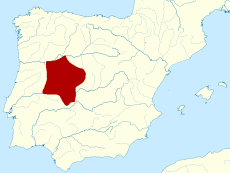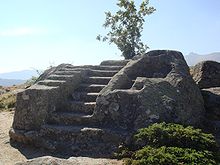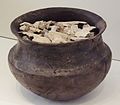Vettones


The Vettones (Greek: Ouettones) were an Iron Age pre-Roman people of the Iberian Peninsula.[1][2]
Origins
Lujan (2007) concludes that some of the names of the Vettones show clearly
Culture

A predominately horse-
Location

The Vettones lived in the western part of the
History

Traditional allies of the
Although technically incorporated around 134-133 BC into
Romanization
In the 1st Century BC, the Romans began to establish military colonies throughout Vettonia, first at Kaisarobriga or Caesarobriga (Talavera de la Reina – Toledo) and Norba Caesarina (near Cáceres), latter followed by Metellinum (Medellín), and in around 27-13 BC the Vettones were aggregated to the newly created Roman province of Lusitania with Emerita Augusta (Mérida) as the capital of the new province.[16]
Despite their progressive assimilation into the Roman world, the Vettones managed to retain their martial traditions, which enabled them to provide the Roman Army with an auxiliary cavalry unit (
Namesake
The Vettones are not to be confused with the Vettonenses, inhabitants of Vettona (today's Bettona) in Umbria.
Gallery
See also
- Arevaci
- Bletonesii
- Carpetani
- Celtiberians
- Celtiberian script
- Cynetes
- Lusitanian Wars
- Sertorian Wars
- Roman civil wars
- Pre-Roman peoples of the Iberian Peninsula
- Ala Hispanorum Vettonum civium Romanorum
Notes
- ^ a b Álvarez-Sanchís, Jesús R. (2005). "Oppida and Celtic society in western Spain". e-Keltoi: Journal of Interdisciplinary Celtic Studies, Vol. 6 (The Celts in the Iberian Peninsula).
- ^ Cremin, The Celts in Europe (1992), p. 57.
- ISBN 978-1-84217-475-3.
- ^ Conrad Cichorius, Römische Studien (Berlin, 1922).
- ^ Plutarch, Quaestiones Romanes, question 83.
- ^ Edmondson, "A criação de uma sociedade provincial romana" (2022), p. 36.
- ^ Silius Italicus, Punica, III, 378.
- ^ Ptolemy, Geographika, II, 5, 7.
- ^ Conrad Cichorius, Römische Studien (Berlin, 1922).
- ^ Plutarch, Quaestiones Romanes, question 83.
- ^ Silius Italicus, Punica, III, 378-414.
- ^ Appian, Iberiké, 57.
- ^ Livy, Periochae, 47.
- ^ Matyszak, Sertorius and the struggle for Spain (2013), pp. 79; 144.
- ^ Caesar, De Bello Civili, I, 38, 1-4.
- ^ Garcia y Bellido, Antonio (1958). Las colonias romanas de la provincia Lusitania (PDF). Antigua: Historia y Arqueología de las civilizaciones. pp. 3, 4.
- ^ "El caballo en la sociedad celtibérica". 24 September 2015.
Bibliography
- Aedeen Cremin, The Celts in Europe, Sydney, Australia: Sydney Series in Celtic Studies 2, Centre for Celtic Studies, University of Sydney (1992) ISBN 0-86758-624-9
- Ángel Montenegro et alii, Historia de España 2 - colonizaciones y formación de los pueblos prerromanos (1200-218 a.C), Editorial Gredos, Madrid (1989) ISBN 84-249-1386-8
- Christophe Bonnaud, Les castros vettons et leurs populations au Second Âge du Fer (Ve siècle-IIe siècle avant J.-C.), I: implantation et systèmes défensives in Revista Portuguesa de Arqueologia, pp. 209–242, volume 8, número 1, IPA Lisboa (2005) ISSN 0874-2782
- Christophe Bonnaud, Les castros vettons et leurs populations au Second Âge du Fer (Ve siècle-IIe siècle avant J.-C.), II: l’habitat, l’économie, la société in Revista Portuguesa de Arqueologia, pp. 209–242, volume 8, número 2, IPA Lisboa (2005) ISSN 0874-2782
- Eduardo Sánchez Moreno, Vetones: Historia y Arqueología de un pueblo prerromano, Ediciones de la Universidad Autónoma, Madrid (2000) ISBN 84-7477-759-3
- Francisco Burillo Mozota, Los Celtíberos, etnias y estados, Crítica, Grijalbo Mondadori, S.A., Barcelona (1998, revised edition 2007) ISBN 84-7423-891-9
- Isabel Baquedano Beltrán, La necrópolis vettona de La Osera (Chamartín, Ávila, España) – volumen I, Zona Arqueológia número 19-I, Museo Arqueológico Regional, Alcalá de Henares (2016) ISBN 978-84-451-3518-1
- Isabel Baquedano Beltrán, La necrópolis vettona de La Osera (Chamartín, Ávila, España) – volumen II, Zona Arqueológia número 19-II, Museo Arqueológico Regional, Alcalá de Henares (2016) ISBN 978-84-451-3518-1
- Manuel Salinas de Frías, Los vettones: indigenismo y romanización en el occidente de la meseta, Ediciones Universidad Salamanca, Salamanca (2001) ISBN 84-7800-881-0
- Martín Almagro-Gorbea & Ana Maria Martín, Castros y Oppida en Extremadura, Editorial Complutense, Madrid (1994) ISBN 84-7491-533-3
- Jesús R. Álvarez-Sanchís, Los vettones, Real Academia de la Historia, Madrid (2003) ISBN 9788495983169
- Jesús R. Álvarez-Sanchís, Los señores del ganado – Arqueología de los pueblos prerromanos en el occidente de Iberia, Colección Arqueología, Editorial Akal, Madrid (2003) ISBN 84-460-1650-8
- Jonathan Edmondson, "A criação de uma sociedade provincial romana" in A Lusitânia Romana: fronteira do mundo antigo, National Geographic História, edição especial, RBA Revistas S.L., Barcelona (2022), pp. 34-43. ISSN 2696-7979
- Philip Matyszak, Sertorius and the struggle for Spain, Pen & Sword Military, Barnsley (2013) ISBN 978-1-84884-787-3
Further reading
- Barry Cunliffe, The Celts – A Very Short Introduction, Oxford University Press (2003) ISBN 0-19-280418-9.
- Dáithí Ó hÓgáin, The Celts: A History, The Collins Press, Cork (2002) ISBN 0-85115-923-0
- Daniel Varga, The Roman Wars in Spain: The Military Confrontation with Guerrilla Warfare, Pen & Sword Military, Barnsley (2015) ISBN 978-1-47382-781-3
- Leonard A Curchin (5 May 2004). The Romanization of Central Spain: Complexity, Diversity and Change in a Provincial Hinterland. Routledge. pp. 37–. ISBN 978-1-134-45112-8.
- Ludwig Heinrich Dyck, The Roman Barbarian Wars: The Era of Roman Conquest, Author Solutions (2011) ISBNs 1426981821, 9781426981821
- Luis Silva, Viriathus and the Lusitanian resistance to Rome 155-139 BC, Pen & Sword Military, Barnsley (2013) ISBN 978-1-78159-128-4
- John T. Koch (ed.), Celtic Culture: A Historical Encyclopedia, ABC-CLIO Inc., Santa Barbara, California (2006) ISBN 1-85109-440-7, 1-85109-445-8












